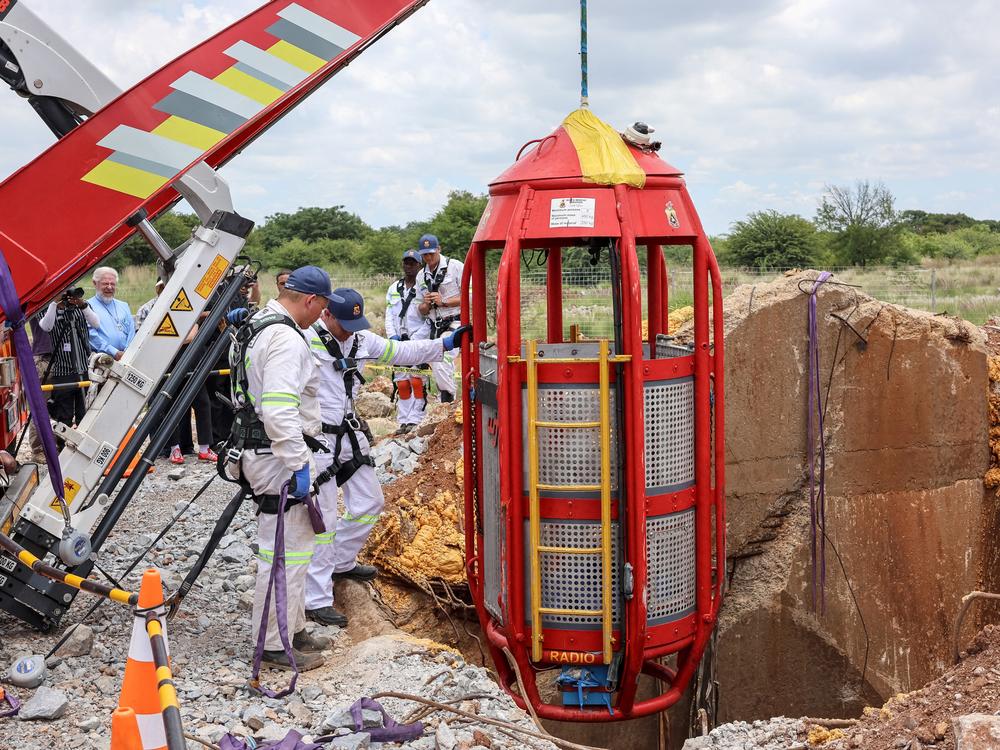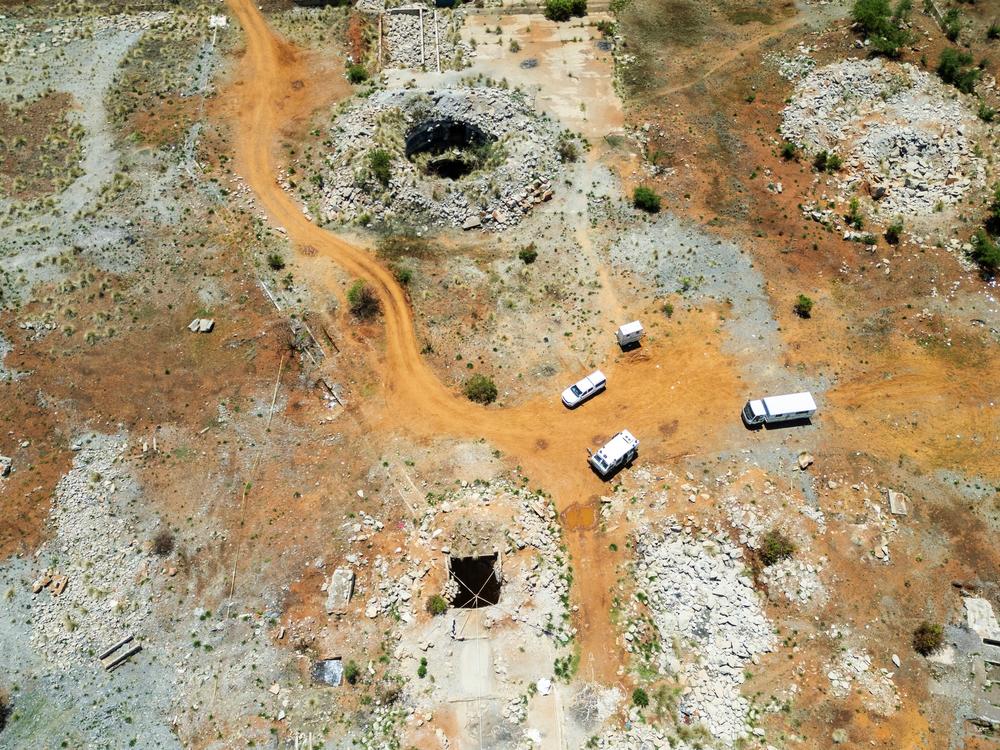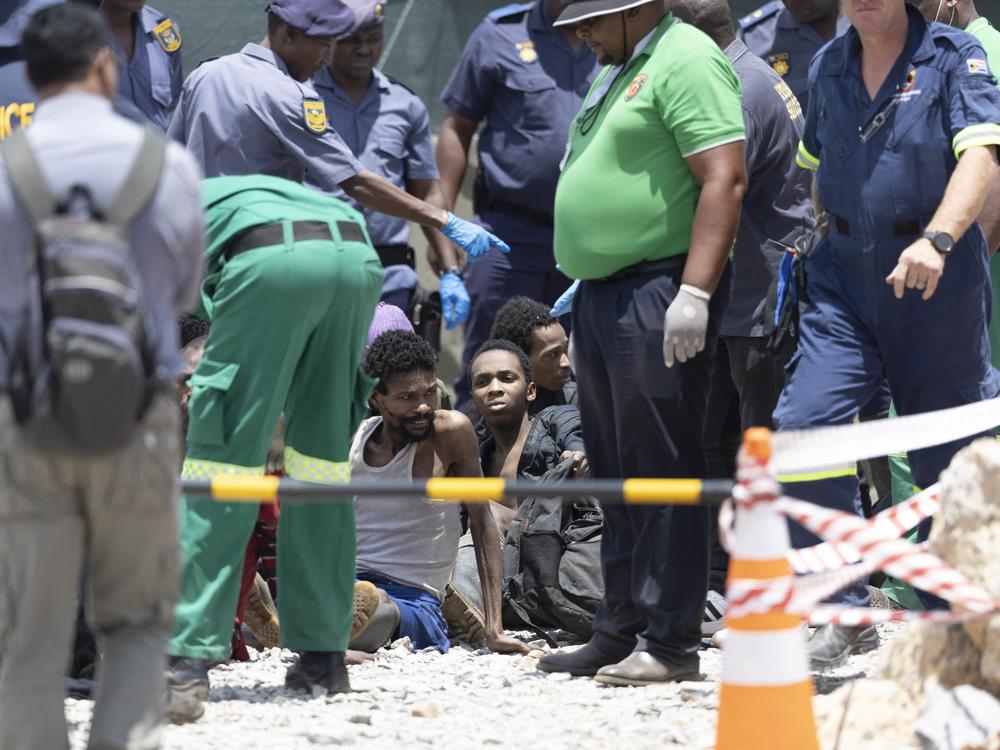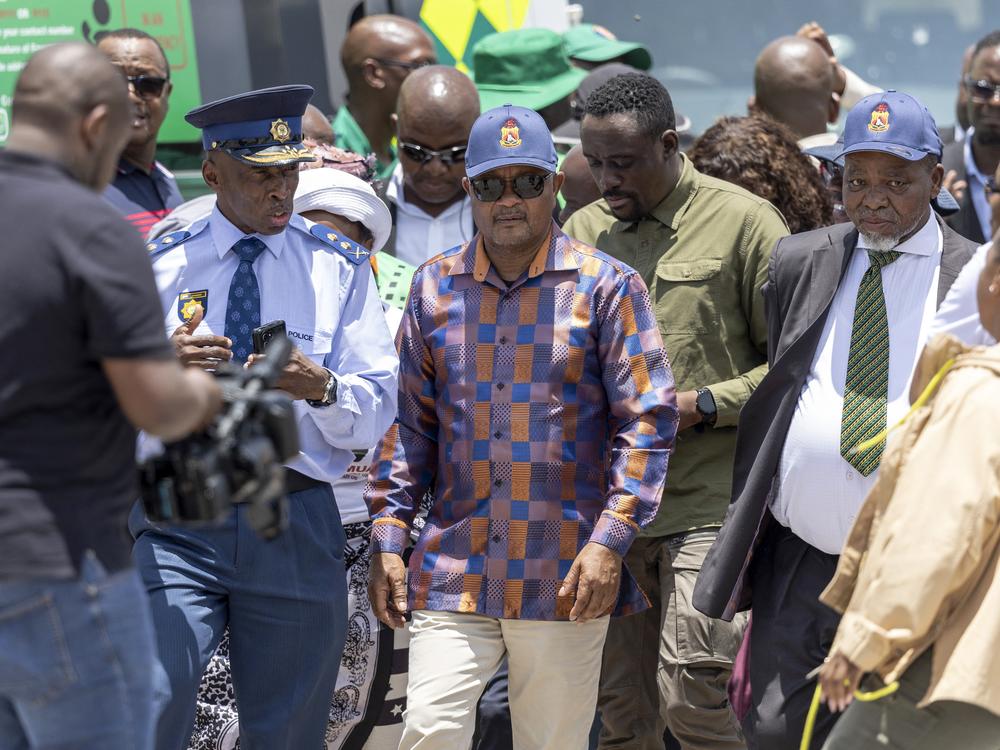Section Branding
Header Content
A South African horror story: illegal mining stand-off draws to an end
Primary Content
STILFONTEIN, South Africa —They look like the walking dead. Dusty men, skin and hair caked in dirt, skeletal. Some struggle to walk and collapse. They blink like moles in the harsh South African sunlight. Some look painfully young.
Operations to rescue hundreds of illegal miners at an abandoned gold mine in Stilfontein, a small mining town about 100 miles Southwest of Johannesburg, started Monday and ended Thursday when rescuers said there was no longer anyone left in the shaft.
In total during the rescue operation, 246 illegal gold miners were brought to the surface alive. Seventy-eight more were brought up dead.
Known here as "zama zamas" or "those who take a chance" in Zulu, the illegal miners have been underground for months, with their condition deteriorating rapidly after police cut off their food and water supplies in November as part of Operation "Vala Umgodi," or "close the hole."
The authorities said this was done to get them to resurface, or as one minister put it "smoke them out," so that they could be arrested. At first, police said they were in a standoff with the illegal miners, who were refusing to come up of their own accord because they feared arrest.
But as the weeks wore on, community activists and trade unions said the men had become too emaciated and weak to make the hazardous two-kilometre climb up the mineshaft back to the surface even if they wanted to.
Earlier this month a mine workers union shared videos taken underground of how dire the situation had become. In one video an unknown miner, his ribs sticking out, begs for help. Another video showed how the miners were living among dozens of corpses.
In affidavits filed to court, several zama zamas who had resurfaced since the police operation started shared harrowing details about life underground, with people eating cockroaches or surviving on toothpaste for sustenance.
Mzukisi Jam, a local community leader who has been at the abandoned mine for more than two months organizing getting supplies down to the illegal miners, pulls no punches in his criticism of the government.
Standing at the dirt road leading down to the rescue site in Stilfontein, where ambulances waited for survivors and people in hazmat suits handled bodies, Jam said "a massacre" had taken place.
"We're not going to celebrate and give accolades and say thank you to the government," he told NPR. "We started communicating with the government before there was even a single fatality…but they had to wait until people started dying."
Near the enormous hole leading to the disused mineshaft, specialized machinery was used to lower a cage down to bring up the men and the bodies. It can bring up about seven people at a time and takes around an hour per rotation. No police or rescue workers would go down, saying the risks were too high, so it was left to ordinary volunteers from the local township to undertake the devastating task.
Zinzi Tom, whose 26-year-old brother has been underground since July, has been advocating for government help for months. After several organizations went to court to try and force the government to relent, she eventually brought the final court case that saw the rescue operation ordered this month.
"We have knocked on many doors, pleading with the government, help us," she said. "Our government only knows that you are human beings when it needs votes."
Her brother, Ayanda, is the father of two young children. He had looked for work unsuccessfully she said, and was driven by desperation to eke out a dangerous living deep underground.
She has been outside the rescue site day after day, along with a small but vocal group of family and community members singing protest songs and holding signs reading "#Black Lives Matter" and "Every Life Counts. Stop Xenophobia."
Many here think the fact that most of the Stilfontein zama zamas are Mozambicans and Zimbabweans has played a big part in the government's attitude. And, in fact, many ordinary South Africans have been unmoved by their plight, with countless comments on social media platforms saying they should be left to die.
Anti-immigrant sentiment is high in South Africa, where migrants are often used as scapegoats for other problems. Youth unemployment in South Africa is at over 45 percent.
Stilfontein is a microcosm of the post-apartheid government's failure to better the lives of many poor black people. Cows graze in green fields, but the landscape is pockmarked with large mine dumps, many now shuttered.
South Africa was once the world's largest gold producer, but large-scale industrial mining became unprofitable and many mines have closed, laying off tens of thousands of workers.
Samuel Sehebeng, 47, sitting having a midmorning drink at a tavern in the nearby dusty township of Khuma, is one of them.
"We are a mining town, our economy is dependent on mining, but recently most of the mines have closed down so the local economy is suffering a lot," he told NPR. "I used to work in the mining industry, I lost my job, full retrenchment. It was in 2017, since then I've been unemployed."
Sehebeng says he feels sympathy for the men who take up the life of the zama zama. There are thousands of abandoned mine shafts where they can search for a tiny fraction of the gold that made this country rich.
The government has long vowed to get tough on illegal mining, which they say cost the South African economy 60 billion rand ($3 billion) in 2024. They say the zama zamas are sometimes violent criminals who terrorise their communities.
But experts on illegal mining say there are different hierarchies in the zama zama-world; the heavily armed gang leaders who run operations, brutalise and coerce their underlings, and are getting rich, and the ordinary men who risk life and limb underground for a pittance.
"Darkest Point in Our History"
On 10 January, more than two months after news of the crisis at Stilfontein had emerged, the Pretoria High Court ordered the government to launch a rescue operation.
"We do not want a situation where this will be marked as the darkest point in our history," the judge said in his ruling.
But by the time the rescue operations ended on Thursday, with 78 dead, Stilfontein might indeed prove one of the darkest episodes of South Africa's post-apartheid era.
While one party in South Africa's coalition government, the Democratic Alliance, has belatedly condemned what's taken place at Stilfontein, members of the largest party in government, the African National Congress, are sticking to their guns.
"You attack the economy of South Africa, you are declaring war on the economy, I can't be your partner," Minister of Minerals and Energy Gwede Mantashe told a press briefing on Tuesday at the mine site.
After the press briefing Mantashe and police minister Senzo Mchunu walked up the road to address furious families and protesters. But they were shouted down and chased away, quickly clambering into awaiting black BMWs and being driven off.
Bringing Up the Bodies
The rescued illegal miners will all now face prosecution and police said Thursday they had also arrested some of the Zama Zama kingpins.
The rescued illegal miners will all now face prosecution and police said Thursday they had also arrested some of the Zama Zama kingpins.
Meanwhile the government faces a reckoning, with some civic groups calling for a commission of inquiry or even for murder charges to be brought against the state. For their part, the police have vowed Operation Vala Umgodi will continue.
Now that the rescue mission is complete, the daunting task of identifying the almost 80 bodies also begins.
"The only thing that we're appreciating is that at least the families will get the opportunity to bury their loved ones," says community leader Mzukisi Jam.
Whether they even get to do that is still to be seen.
NPR spoke to a forensic pathology officer onsite at the morgue at a hospital in the nearby town of Klerksdorp. The officer, who did not want to be named because he was not authorized to speak to the media, said the facility was full, with about thirty dead zama zamas awaiting forensic investigation.
He added that many were in a bad state of decomposition because it had been so hot down the mine shaft. And some, with a bleak foreshadowing of what was to come, had written their names and the phone numbers of family members – on their chests.





